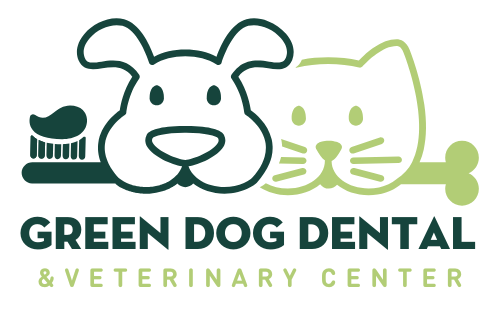
Periodontal disease is one of the most common ailments in both dogs and cats, nearly 90% of adult pets to some degree, and at Green Dog Pet Products, we see so many of these preventable issues. Dental disease causes all sorts of problems, including bad breath, tooth decay and tooth loss, mouth pain, gum problems, and even chronic infections.
POOR PET ORAL HYGIENE IS PART OF THE CAUSE
Moreover, poor oral hygiene does not end in the mouth: persistent periodontal disease can cause infection that can spread to other areas of your pet’s body, including the liver, lungs, heart, and kidneys.
Because both cats and dogs are pretty adept at hiding their pain, owners are often astonished to find out that their furry friend is experiencing serious dental and gum disease. In fact, many animals require multiple extractions by the time they make it to the veterinarian for a professional dental cleaning.
IT DOES NOT NEED TO BE THIS WAY!
But it doesn’t have to be this way! Regular preventative dental care is crucial, as is recognizing clinical signs of dangerous dental problems. There are a few telltale signs of periodontal disease in dogs and cats. The first, and perhaps the most obvious to pet parents, is bad breath.
BAD BREATH IS A BIGGER PROBLEM THAN YOU THINK
Most animals have funky breath to some degree, but there is a distinct difference between regular kibble breath and the odorous breath of dental disease. If your pet suddenly has stinkier breath than usual, that’s a clue that trouble may be brewing, and you should get it checked out.
ACTIVELY WATCH FOR SWOLLEN GUMS
Another sign of dental problems in dogs and cats are red, swollen or bleeding gums. Health cat and dog gums should be pleasantly pink. If you begin to see redness forming around the edges of their teeth or notice streaks of blood on their toys or in their mouths, that’s a sign that your pet may have gingivitis, which is an early form of periodontal disease.
PET GUM DISEASE
More serious gum diseases can present with more serious symptoms, such as sores, pus, or excessive bleeding. If your dog or cat is having dental problems, another thing you may notice is excessive drooling.
Lots of dogs (and even some cats!) will drool on a regular basis, but if your dog starts drooling suddenly, or their drooling gets worse than normal (“hypersalivation”), it could indicate that something is wrong.
Dental disease and mouth pain are the most common causes of excessive drooling. If you notice your pet is more slobbery than normal, a trip to the vet is definitely warranted.
WATCH FOR PLAQUE AND TARTER
You may also notice yellow or brown plaque and tartar on your dog or cat’s teeth. This is one of the most visual signs of dental disease, and, other than being unsightly, can cause all sorts of issues in your pet’s mouth.
By the time the plaque is yellow or brown, it’s incredibly difficult or even impossible to remove with brushing with a toothbrush. To get that gunk off your pet’s teeth you’ll need to visit your vet who will perform a professional dental cleaning, also known as a “dental scaling”.
THE TRUTH ABOUT EATING HABITS
Finally, a change in eating habits can also be indicative of a dental problem. Periodontal disease can often by painful, and if your pet is reluctant to eat or seems to favor softer foods, it could be a sign that their teeth or gums are hurting.
As always, remember that periodontal disease is almost always preventable! While most pets will need a professional dental scaling at some point during their lifetime, preventative care at home is the best thing you can do to keep your pet’s mouth healthy. To learn more, check out our article on How to Care for Your Dog's Teeth.
